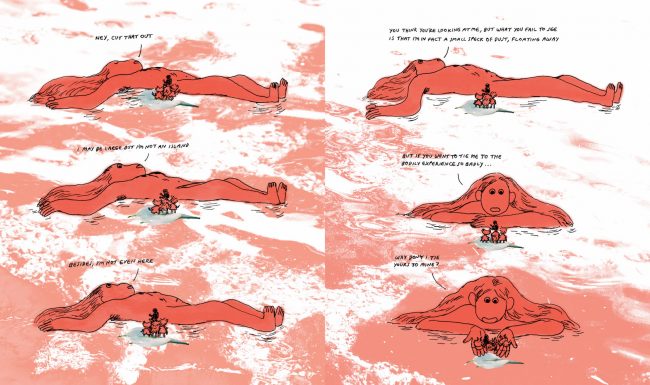Imagine if you lived in the world of a painting – not the world it was representing, but the physicality of its painted world. You could walk along the raised brushstrokes of Monet’s Waterlilies, find yourself following the swirls of Van Gogh’s Starry Night, hop from gold leaf to gold leaf in Klimt’s The Kiss. What if, instead, your journey wound through the craft strewn floor beneath a child’s desk? What might a bit of foil, a piece of tulle, a smudge of glitter glue look like from a minuscule perspective? Something special, I imagine. How would the world look after such a foray? Could you tell the difference between real and artificial, internal and external, fantasy and reality? Would such a thing matter? Disa Wallander’s Becoming Horses, presents just such an imaginary journey and might be best described as a visual stream of consciousness. The bright and precarious world of Becoming Horses reflects an inner monologue, an emotional landscape, that is more line, shape, texture, color, and the journey of discovery that ensues through their free association. Wallander’s presentation does what all art should: show things in new light, create an intimate encounter with the viewer, experiment a little, and ask us to focus for a moment on one glimmering object before moving onto the next. Becoming Horses suggests that, it’s not so much about how things look – art, the world, or the people around you – but rather, how looking can make you see differently.
For Wallander, this journey isn’t strictly observational, it is an investigation into the self, into the other, into the collective. Wandering about a mixed media world, moving more through multiple layers of images rather than strictly sequences, Wallander’s characters question their world, themselves, and each other: “Was it always like this?” “Where did I go?” “What are you doing?” “Why are you doing it?” Wallander’s imaginative world suggests that whether alone or with others, we each take an artistic journey, even if we don’t consider it as such. She highlights the difficulty of communicating the sensations we feel through our emersion in nature, what it is to live in a body and perform the idea of self through it, how we endeavor to encompass fleeting moments and feelings, our desire to create something meaningful, and our attempt to understand ourselves through perpetual forays into self-expression. All of these human desires, Wallander proposes, are both the process and product of art itself – a gateway to self and others through crude but powerful attempts at communication and understanding.
 The brilliance of Wallander’s work is in the wispy line figures that carry the reader through the dynamic artistic landscapes of her text. These crudely drawn, barely contoured characters feel as though they may scatter from the page if you turn it with too much force. However, these scant figures allow the reader to immerse themselves in the texture of the page, in the opacity of rolled clay, in the sumptuousness of acrylic swirls, in the density of twirls of hair, without detracting from their material presence. In this text, the artistic materials are more material than the figures themselves.
The brilliance of Wallander’s work is in the wispy line figures that carry the reader through the dynamic artistic landscapes of her text. These crudely drawn, barely contoured characters feel as though they may scatter from the page if you turn it with too much force. However, these scant figures allow the reader to immerse themselves in the texture of the page, in the opacity of rolled clay, in the sumptuousness of acrylic swirls, in the density of twirls of hair, without detracting from their material presence. In this text, the artistic materials are more material than the figures themselves.
The materials’ presence over that of the characters foregrounds the artistic process as a means to an end in itself. Horses does not ask, “What qualifies as art?” or “Which type of art is valuable?” rather, it suggests that all artforms are simply a bridge – a medium of exchange – connecting us to our own thoughts, ideas, desires, emotions, hopes, and fears, and potentially to others’.
 Horses is a strange and wonderful journey where each observed object changes before your eyes, always becoming, transforming through a series of perspectives. If anything, Horses forces you to look, again and again, at the object before you, at your environment, at yourself. Through this imaginative journey, you might find yourself, lose yourself, become something other than what you thought you were. You may be comforted, confronted, moved, charmed, saddened, uplifted, or all simultaneously. You may see yourself in Horses, or you may not, but ultimately, Horses will make you think about seeing, differently.
Horses is a strange and wonderful journey where each observed object changes before your eyes, always becoming, transforming through a series of perspectives. If anything, Horses forces you to look, again and again, at the object before you, at your environment, at yourself. Through this imaginative journey, you might find yourself, lose yourself, become something other than what you thought you were. You may be comforted, confronted, moved, charmed, saddened, uplifted, or all simultaneously. You may see yourself in Horses, or you may not, but ultimately, Horses will make you think about seeing, differently.







